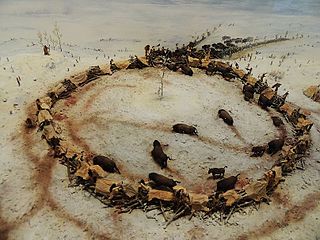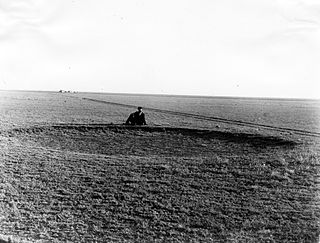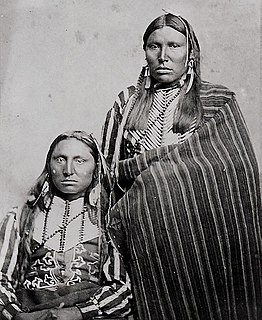 W
WBison hunting was an activity fundamental to the economy and society of the Plains Indians peoples who inhabited the vast grasslands on the Interior Plains of North America, prior to the animal's near-extinction in the late nineteenth century following US expansion into the West. Bison hunting was an important spiritual practice and source of material for these groups, especially after the European introduction of the horse in the 16th through 18th centuries enabled new hunting techniques. The species' dramatic decline was the result of habitat loss due to the expansion of ranching and farming in western North America, industrial-scale hunting practiced by non-indigenous hunters, increased indigenous hunting pressure due to non-indigenous demand for bison hides and meat, and cases of deliberate policy by settler governments to destroy the food source of the native Indian peoples during times of conflict.
 W
WThe Buffalo Hunters' War, or the Staked Plains War, occurred in 1877. Approximately 170 Comanche warriors and their families led by Quohadi chief Black Horse or Tu-ukumah left the Indian Territory in December, 1876, for the Llano Estacado of Texas. In February, 1877, they, and their Apache allies, began attacking buffalo hunters' camps in the Red River country of the Texas Panhandle, killing or wounding several. They also stole horses from the camp of Pat Garrett.
 W
WA buffalo jump, or sometimes bison jump, is a cliff formation which Native Americans historically used to hunt and kill plains bison in mass quantities. The broader term game jump refers to a man-made jump or cliff used for hunting other game, such as reindeer.
 W
WThe buffalo pound was a hunting device constructed by native peoples of the North American plains for the purpose of entrapping and slaughtering American bison, also known as buffalo. It consisted of a circular corral at the terminus of a flared chute through which buffalo were herded and thereby trapped. David Mandelbaum's The Plains Cree contains diagrams and a complete description of the construction and use of such a pound.
 W
WBuffalo rifle generally refers to large-calibre, generally single-shot black powder cartridge firearms which were used to hunt the American Bison to near-extinction in the late-19th Century. Three types of rifles in particular were used by professional buffalo hunters, namely the Sharps rifle, the Springfield Rifle and the Remington No.1 rifle otherwise known simply as the Rolling block. The Sharps was the favorite among hunters because of its accuracy at long range.
 W
WThe Buffalo Soldier tragedy of 1877, also known as the Staked Plains Horror, occurred when a combined force of Buffalo Soldier troops of the 10th Cavalry and local buffalo hunters wandered for five days in the near waterless Llano Estacado region of north-west Texas and eastern New Mexico during July of a drought year, where four soldiers and one buffalo hunter died.
 W
WA buffalo wallow or bison wallow is a natural topographical depression in the flat prairie land that holds rain water and runoff.
 W
WThe Extermination of the American Bison is a book by William Temple Hornaday first published in 1889. It was reprinted from a report Hornaday wrote for the Smithsonian Institution in the years 1886–87.
 W
WFirst Peoples Buffalo Jump State Park is a Montana state park and National Historic Landmark in Cascade County, Montana in the United States. The park is 1,481 acres (599 ha) and sits at an elevation of 3,773 feet (1,150 m). It is located about 3.5 miles (5.6 km) northwest of the small town of Ulm, which is near the city of Great Falls. First Peoples Buffalo Jump State Park contains the Ulm Pishkun, a historic buffalo jump utilized by the Native American tribes of North America. It has been described as, geographically speaking, either North America's largest buffalo jump or the world's largest. There is some evidence that it was the most utilized buffalo jump in the world. The site was added to the National Register of Historic Places on December 17, 1974, and designated a National Historic Landmark in August 2015. The former name of the park was derived from the Blackfeet word "Pis'kun," meaning "deep kettle of blood," and the nearby town of Ulm.
 W
WFolsom Site or Wild Horse Arroyo, designated by the Smithsonian trinomial 29CX1, is a major archaeological site about 8 miles (13 km) west of Folsom, New Mexico. It is the type site for the Folsom tradition, a Paleo-Indian cultural sequence dating to between 9000 BC and 8000 BC. The Folsom Site was excavated in 1926 and found to have been a marsh-side kill site or camp where 23 bison had been killed using distinctive tools, known as Folsom points. This site is significant because it was the first time that artifacts indisputably made by humans were found directly associated with faunal remains from an extinct form of bison from the Late Pleistocene. The information culled from this site was the first of a set of discoveries that would allow archaeologists to revise their estimations for the time of arrival of Native Americans on the North American continent.
 W
WThe game drive system is a hunting strategy in which game are herded into confined or dangerous places where they can be more easily killed. It can also be used for animal capture as well as for hunting, such as for capturing mustangs. The use of the strategy dates back into prehistory. Once a site is identified or manipulated to be used as a game drive site, it may be repeatedly used over many years.
 W
WThe Battle of Grand Coteau or the Battle of Grand Coteau du Missouri was a battle that took place between a Metis buffalo hunting party from St. François Xavier, led by Jean Baptiste Falcon and the Cut Head (Pabaksa) Yanktonai (Ihanktonwanna), Dakota, led by Chief Medicine (Sacred) Bear, on July 13 to 14, 1851. The Métis were victorious. It was the last major battle between the two groups.
 W
WMétis buffalo hunting began on the North American plains in the late 1700s and continued until 1878. The great buffalo hunts were subsistence, political, economic, and military operations for Métis families and communities living in the region. At the height of the buffalo hunt era, there were two major hunt seasons: summer and autumn. These hunts were highly organized, with an elected council to lead the expedition. This made sure the process was fair and all families were well-fed and provided for throughout the year.
 W
WWilliam J. Oliphant (1845–1930) was an American Confederate States Army veteran and photographer from Austin, Texas. He published the first photographs of buffalo hunts in North America.
 W
WThe Battle of Yellow House Canyon was a battle between a force of Comanches and Apaches against a group of American bison hunters that occurred on March 18, 1877, near the site of the present-day city of Lubbock, Texas. It was the final battle of the Buffalo Hunters' War, and was the last major fight involving the United States and Native Americans on the High Plains of Texas.